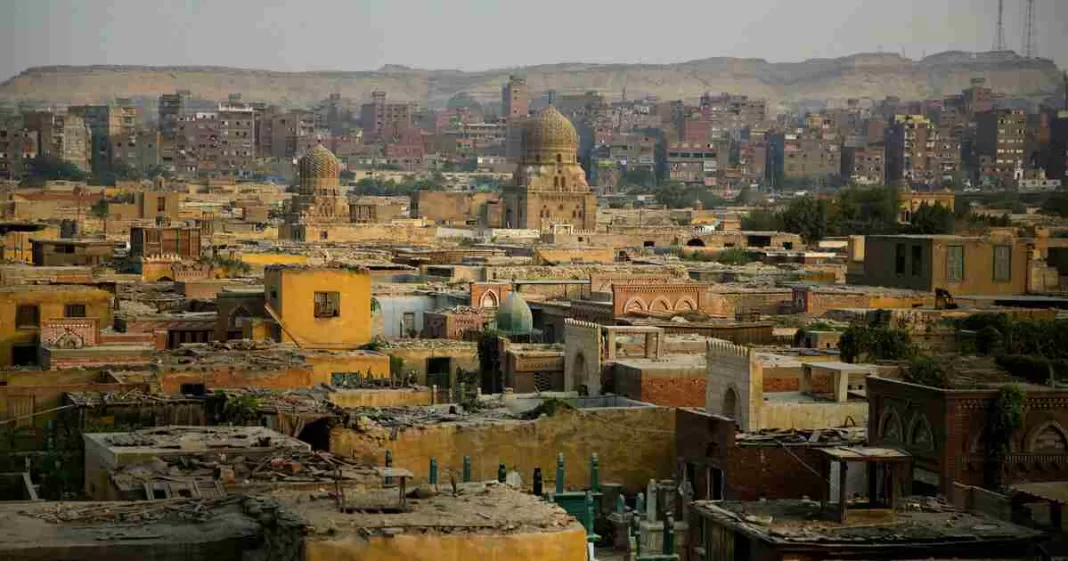Cairo’s City of the Dead, also known as al-Qarafa, is a historic necropolis that has served as the resting place for countless generations of Egyptians for over 1,400 years. Within its sprawling confines lie the mausoleums of prominent politicians, poets, singers, and Islamic figures, reflecting the rich tapestry of Egypt’s history. However, recent development plans have threatened this cultural treasure, sparking a passionate movement to protect these historic sites.
Family’s Legacy
For Hussein Omar’s family, the City of the Dead holds a profound connection spanning eight generations. Their family mausoleum, commissioned in 1924 by Fathallah Pasha Barakat, stands as a testament to Egypt’s post-independence era and the leader’s role in the 1919 anti-colonial revolution. Ornamented with Ottoman, European, and Islamic design elements, it showcases the intricate fusion of cultural influences that have shaped Egypt’s history.
Read More: Rapper Travis Scott’s concert at Egypt’s pyramids cancelled
Threat to History
The threat to the City of the Dead emerged with ambitious development projects proposed by President Abdel Fattah el-Sisi’s administration. These plans included the construction of flyover bridges and highways that would carve through the UNESCO World Heritage site, connecting Cairo with a new administrative capital. While the government asserted that it targeted modern structures, concerns arose when activists claimed that valuable artifacts had been unearthed during construction.
Power of Social Media
Hussein Omar, now living in New York, learned about the demolition plans through social media, particularly Twitter, where a photograph of his mother’s grave was tagged #SAVEEGYPTSHERITAGE. The images circulated on social platforms ignited widespread anger and concern. Still, what became evident was the public’s limited awareness of the historical and aesthetic significance of these mausoleums, primarily due to their private nature.
Ancient Resting Place
The al-Qarafa necropolis’s roots date back to the Arab conquest, making it the world’s oldest continually used Muslim cemetery. Set beneath the Mokattam cliffs, it boasts stone dwellings designed to house families’ earthly remains. The cemetery holds religious importance, notably the Imam Shafi’i graveyard surrounding the mausoleum of Imam Shafi’i, a renowned Muslim legal scholar.
Renaissance of Islamic Architecture
Over a century ago, the City of the Dead experienced a renaissance of Islamic architecture, thanks to Italian architects like Mario Rossi. These architects left an indelible mark on the cemetery, crafting elegant and beautiful mausoleums that continue to captivate visitors and historians alike.
Battle for Preservation
Since 2020, Egyptian authorities have relocated thousands of human remains within the City of the Dead, forcing families to exhume and relocate their loved ones to new graves in the desert. This displacement intensified with the government’s push for the expansion of the private real estate sector, leading to the formation of “residential islands” within the necropolis.
Political Agenda
The demolition plans originated as part of President Hosni Mubarak’s “Cairo 2050” vision, which aimed to modernize Cairo through extensive urban development. However, President el-Sisi further accelerated these projects, pouring vast sums into the new administrative capital while attempting to insulate the regime from urban mass politics that had emerged during the 2011 revolution.
The Human Cost
The City of the Dead is not just a historical site; it’s home to destitute Egyptians who have lived there for generations. The housing crisis and deep class divide in Egypt have left many facing displacement. Despite calls for more inclusive solutions, the government has often resorted to removal rather than preservation.
Glimmer of Hope
Recent reports suggest that demolitions in the City of the Dead have temporarily halted, although intense security measures and restrictions on photography persist. This pause offers a moment of respite, but the battle to preserve Egypt’s cultural heritage is far from over.
Read More: Egyptian foreign ministry summons Swedish envoy over offensive protests
Cairo’s City of the Dead stands as a living testament to Egypt’s rich history and cultural diversity. While development plans threaten its existence, a passionate movement has emerged to protect these precious sites. The world watches as Egyptians join together to safeguard their heritage, reminding us all of the enduring value of our shared past.














